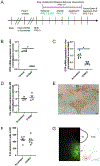Oxytocin receptors in the midbrain dorsal raphe are essential for postpartum maternal social and affective behaviors
- PMID: 34182251
- PMCID: PMC8405581
- DOI: 10.1016/j.psyneuen.2021.105332
Oxytocin receptors in the midbrain dorsal raphe are essential for postpartum maternal social and affective behaviors
Abstract
Oxytocin receptors (OTRs) in the midbrain dorsal raphe (DR; the source of most forebrain serotonin) have recently been identified as a potential pharmacological target for treating numerous psychiatric disorders. However, almost all research on this topic has been conducted on males and the role of DR OTRs in female social and affective behaviors is mostly unknown. This may be particularly relevant during early motherhood, which is a time of high endogenous oxytocin signaling, but also a time of elevated risk for psychiatric dysfunction. To investigate whether OTRs in the DR are necessary for postpartum female social and affective behaviors, we constructed and then injected into the DR an adeno-associated virus permanently expressing an shRNA targeting OTR mRNA. We then observed a suite of social and affective behaviors postpartum. OTR knockdown in the maternal DR led to pup loss after parturition, decreased nursing, increased aggression, and increased behavioral despair. These effects of OTR knockdown in the DR may be due to disrupted neuroplasticity in the primary somatosensory cortex (S1), which mediates maternal sensitivity to the tactile cues from young, as we found significantly more plasticity-restricting perineuronal nets (PNNs) in the S1 rostral barrel field and fewer PNNs in the caudal barrel field of OTR-knockdown mothers. These results demonstrate that OTRs in the midbrain DR are essential for postpartum maternal social and affective behaviors, are involved in postpartum cortical plasticity, and suggest that pharmacotherapies targeting OTRs in the DR could be effective treatments for some peripartum affective disorders.
Keywords: Anxiety; Behavioral despair; Dorsal raphe; Oxytocin; Perineuronal nets; Postpartum.
Copyright © 2021 Elsevier Ltd. All rights reserved.
Conflict of interest statement
Conflict of Interest Statement
The authors have no conflicts of interest to declare.
Figures




References
-
- Benskey MJ, Sandoval IM, & Manfredsson FP (2016). Continuous collection of adeno-associated virus from producer cell medium significantly increases total viral yield. Human gene therapy methods, 27(1), 32–45. - PubMed
-
- Brecht M, Preilowski B, & Merzenich MM (1997). Functional architecture of the mystacial vibrissae. Behavioural brain research, 84(1-2), 81–97. - PubMed
-
- Calcagnoli F, Stubbendorff C, Meyer N, de Boer SF, Althaus M, & Koolhaas JM (2015). Oxytocin microinjected into the central amygdaloid nuclei exerts anti-aggressive effects in male rats. Neuropharmacology, 90, 74–81. - PubMed
-
- Caldwell HK (2018). Oxytocin and sex differences in behavior. Current opinion in behavioral sciences, 23, 13–20.
Publication types
MeSH terms
Substances
Grants and funding
LinkOut - more resources
Full Text Sources
Medical

